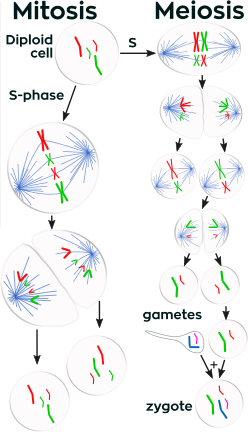Without any biological background the phenomenon 'gene' is like a 'black box'. After a bit of explanation the genetic story becomes easier to understand and remember.
Structure of DNA
Earlier we described DNA as a double chain of 'beads', that takes the shape of a double helix. The properties of those 'beads' are quite interesting too.
The beads are in reality bases (chemical term); there are four types to be precise. Each type is represented by a letter (the first letter of the name of the base): C, G, A and T. Remarkable is that opposite to a C in one chain there is always a G-base in the other chain and opposite to an A is always a T. This is useful when DNA is copied during cell division:
- Splice the DNA chain like a zipper
- Put a complementing base opposite to every base
- Continue until the end of the chains
The result is two identical DNA molecules.
In the introduction you have read that DNA codes for all kinds of properties. To be more precise: it contains the code for making proteins. Proteins consist in their turn of chains of aminoacids. There are more than twenty types of aminoacids which have to be coded with only four 'letters'. A simple calculation shows that you need three letters to make a combination that can at least uniquely represent all aminoacids. This is exactly the solution that nature has found too. Some aminoacids are represented by more than one combination and some combination do not represent any aminoacid (nonsense DNA).
Proteins
The fact that DNA contains the code for proteins is nice, but what is it good for?
We have to take a close look at proteins to find the answer. A chain of aminoacids also has a three dimensional shape. This is determined by the type and sequence of aminoacids. Some aminoacids form internal bridges that determine the three dimensional shape. That shape comes handy when it comes to binding other chemicals to the protein molecule. This way the chemicals come very close to each other and this facilitates chemical reactions between those substances. Proteins can therefore catalyse a chemical reaction. Proteins that have this property are called enzymes.
Another function of protein is found in many structures inside the cell and the body. Muscular movements are caused by proteins moving along each other, oxygen transport is done by a protein, etc.
Enzymes
What is the connection between enzymes and genetic properties?
The answer is actually quite logical. Many properties are no more than the fact that a certain substance is made by the body. A black coat colour is caused by the chemical eumelanine. The reaction that forms this substance is speeded up by an enzyme. If the enzyme is not present (or the spatial structure of the protein is incorrect!) no eumelanine will be formed and the hair is not black.
The influence of the enzyme on the reaction is so big that without the enzyme only neglectable amounts of the chemical are formed.
In short: a property is caused by a chemical. The formation of the chemical (chemical reaction) is catalysed by enzymes, which are coded by the DNA.
A small error in the DNA can easily result in a bad or non-working enzyme, which causes the property to (partly) disappear.
Cell division

As well for growth as for reproduction new cells must be formed. For growth this is done by mitosis and for reproduction by meiosis.
Mitosis
A few events in the cell division are important for the genetic story:
- DNA (chromosome) is copied
- The nuclear membrane disappears
- Each of the copies of the DNA moves to one half of the cell (the chromosomes appear to split)
- The nuclei are formed again
- The cell itself divides
Meiosis
Meiosis (or reduction division) starts with a mitotic division, followed by:
- The disappearance of the nuclear membrane
- The chromosomes of each pair find each other in the centre of the cell
- Each chromosome of a pair moves to one half of the cell
- The nuclear membranes are formed again
- The cell itself divides
Each of the cells now only contains half of the number of chromosomes. Of the 78 chromosomes of the dog these cells only contain 39 of them. These cells are however special cells: reproductive cells. During the reproduction process these half sets of chromosomes of the male and the female animal are combined, resulting in a full set of chromosomes.
Crossing over
During meiosis the chromosomes of each pair move to the centre of the cell. The chromosomes are so close together that during the move to the new cell halves, parts of one chromosome are swapped with the other chromosome.
Genetic properties that are normally linked because they are situated on the same chromosome can be separated in this way. Another trick of mother nature to increase the genetic variance.
The frequency of the separation of properties depends on the distance between the loci on the chromosome. The chances of separating are clearly smaller when the loci are closer together.